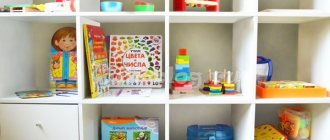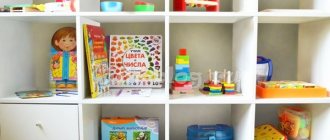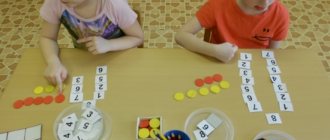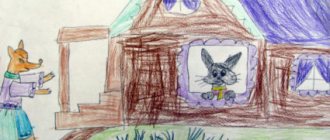Kindergartens and child development centers operating according to the Montessori system attract parents by the way they communicate with children, and last but not least, by the Montessori materials. It's truly hard to put down these educational games and sets! But their meaning is not only in beauty, but also in the benefits that they bring to the development of the child. We tell you how to conduct games using the Montessori method at home.
The entire Montessori classroom is dedicated to the development of sensory experiences. First of all, the child is asked to find pairs of objects that differ in only one characteristic, for example, height, length or thickness. In other exercises, he must find pairs of identical objects by weight, smell, taste, temperature or sound. Later, the child is asked to organize a group of objects in order based on one feature: for example, length, height, shade of color, shape, etc.
Children find these games and riddles interesting because they are challenging enough to be reasonably stimulating. They also learn the names of objects, from geometric shapes to plants and animals.
Today you will find 6 games to determine the color, shape and size of objects, as well as 4 activities to develop tactile sensitivity.
The activities we offer here are simpler than those practiced in Montessori schools, but are based on the same principles. You can make many items for them yourself, or perhaps they are already among your baby’s toys.
Sorting objects (2–5 years)
Sorting objects by shape, color or other physical characteristics is a great activity that encourages children to look closely at objects and make logical choices. You need several sets of items that differ in shape, color and size. Be careful with small objects as small children may swallow them or put them in their nose or ears.
A good option is button sorting. Buy or find at home several sets of four or more identical buttons. Mix them in a large bowl, then show your child how to pick one button, put it in a smaller bowl, and pick out all the same buttons from the larger bowl.
Montessori at home for children 1-2 years old
Now let's move on directly to Montessori classes for children of our age category. For convenience, we will divide them into groups, although in reality almost all exercises involve different areas of child development.
Montessori classes for children's sensory development from 1 to 3
This is the largest category that introduces the child to the qualities of objects: colors, shapes, sizes, materials, temperatures, and so on.
- Create boxes with “interesting things”: large hairpins, jars, lids, bottles, dishes, accessories, natural materials. This set is useful for many games: you can simply sort them out in your hands, bury them in the sand, look for pairs, sort them, throw them into a bucket or bowl of water, and so on,
- Buy your first sorter, an insert puzzle, a set of cubes of different sizes, and a pyramid. Present the sets intermittently, regularly putting different selections of games on the shelf,
- Create sensory material with your own hands: take small (side about 10-15 cm) squares of cardboard and, using glue, apply different materials (scraps of fabric, sand, small pebbles, cereals, foil) to one side; sew small bags and fill them with cereals, cotton wool, dry leaves, stones. In games with such material, ask your child to find pairs, make it more difficult by blindfolding the child,
- Consider purchasing musical instruments and sounding materials from a classic Montessori set,
- It would be great to create your own selection of food flavorings and essential oils,
- You can come up with interesting games for your baby using ordinary scraps of fabric: you can look for pairs, see which ones fall faster if you throw them, sort them by color and material,
- Playing with water is a different story: you can heat it up and freeze it, watch the ice melt, tint it, pour it and wipe it, pour it into different containers, and much more.
Montessori development of gross and fine motor skills for children from one year old
- Many of the activities in the previous section are great for fine motor skills, such as burying objects in the sand, handling objects and sensory cards, playing with water, practicing with Montessori materials,
- To develop gross motor skills, organize the daily routine and environment for the child in a convenient way: let the baby get up and walk around the house as often as possible, climb on chairs and sofas, use a cart or stroller to hone walking skills, be sure to walk in the fresh air, run with the dog and jumps through puddles,
- Rhythmic and gymnastics classes, ball games and even many everyday activities (for example, carrying a full glass of water to the sink) do a lot to develop the baby’s coordination,
- Games with clothespins have proven themselves well among Montessori parents: first, you can put ordinary, loose clothespins in a box and invite the baby to fasten them along the sides, then you can complicate the task by offering to distribute the clothespins by color or start using them for their intended purpose,
- Under supervision, the baby can be asked to study small objects: beans, beads, pebbles, shells,
- Montessori lacing and fastenings work great for children from 1.5 to 2 years old. These sets can be purchased in children's stores and from private craftsmen,
- Pricking dots on the provided paper stencil with a pencil or pen trains the hand and is suitable for children approximately 2 years old.
Provide your baby with freedom of movement and monitor his level of physical activity. Montessori children 1 year and a little older should not sit still for long periods of time. The hands of the little fidget should also be busy: no magic is required, the simplest games with objects are enough.
Montessori speech development exercises for children 1-3 years old
Despite the fact that the baby will really speak a little later, during the Montessori period, teachers emphasize the special importance of the age between 1-2 years for the development of children’s speech.
- Down with pacifiers! Agree, you need a pacifier more to quickly make your child calm down. However, it stops the nonverbal dialogue between the baby and mother and slows down its development. Sometimes it is much more useful to listen to a child’s crying and its reasons than to look for ways to quickly stop it,
- Give your child a reason to expand his vocabulary: books with colorful and realistic pictures (about animals, plants, city and country life), walks to new places, visits. The more the baby sees around him, the more different words and their combinations he hears around him,
- Accompany your actions with explanations: “Now we will pour soup from the pan to Andryusha. This is the ladle we have. You can use a ladle to pour soup into a plate.”
- Encourage baby babble, speak to your baby the words he wants to say: “Ay! Right! Give me some soup, mom!”
- Use material to match pictures and real objects, for example, fruit cards and real fruits
Development of household independence using the Montessori method for children from one year old
Until the age of three, the baby is still strongly attached to his mother and follows her everywhere. Many mothers complain that they are torn between caring for the child and doing household chores and do not even suspect that participation in household chores is one of the best developmental activities for children 1-2 years old, according to Montessori teachers.
In the kitchen:
- give your child a bowl of water and a few vegetables, show them how to wash them,
- Teach your child to peel bananas and other fruits,
- Show how to pour milk into flour, mix everything with a spoon,
- Give your child a cloth so he can clean up after himself,
- Closer to 2 years, show how to cut soft foods (boiled vegetables, bananas),
Wash:
- Ask your child to put his things in the washing machine or, conversely, take them out of the machine,
- Give your child time to explore the basket for things, tell him what kind of things he found: “Look, these are mom’s pajamas, and this is dad’s T-shirt, wow, Andryusha found his socks!”
Cleaning:
- Give your baby a small mop, a bucket, a rag, let him help you wipe the dust,
- Let your child wash everything that comes to your mind: dishes, food, toys, rubber slippers, etc.
- Teach your child to water flowers, pour food into a pet’s bowl,
Remember to take time to start and finish any activity: all materials should have their place on the shelves, and the work area should be kept clean. It is at this age that you can teach your baby to keep order on his own.
Montessori creativity classes for children 1-2 years old
- Prepare a comfortable workplace (small chair and table) and a sufficient amount of creative materials (paper, paints, brushes, stencils, natural materials, crayons, pencils, scissors, glue, plasticine)
- Show your child how to use this or that material, look for good ideas (for example, creating stamps from leaves or drawing with ordinary coal from a fire), but do not get carried away with step-by-step instructions, the child should have room for experimentation
Combining multi-colored signs (3–5 years)
Montessori schools use ready-made sets of multi-colored wooden tablets, with the help of which children learn to distinguish primary colors, tones and shades, and also learn their names.
You can make the signs yourself. The signs can be used to create three separate sets of colors. The elements in the set must be the same size and differ only in color.
For kids, you can start with a set containing 6 signs in three colors: two each yellow, red and blue. Ask your child to match the paired signs and learn with him the names of the 3 primary colors.
When the child has mastered this task, prepare a set of signs of 11 pairs of primary colors and tones: yellow, red, blue, green, orange, purple, pink, brown, gray, black and white. Offer to find paired signs and name the colors.
To make it more challenging, create a third set of signs consisting of 7 shades of each of the 9 colors (yellow, red, blue, green, orange, purple, pink, brown, grey). Invite your child to arrange them in order from lightest to darkest. Once all the signs are neatly arranged on the tray, you will have a beautiful display of different colors.
There are also many games with such signs. For example, ask your child to find a sign of the color that is closest to the color of an object in the room. Another option: show your child a plate from the third set of colors and ask him, from memory, to find a plate with a color that is one tone lighter or darker than the one you showed.
The third option is to teach how to create lighter or darker shades by adding white or black paint to the base color. By starting with a base color and adding white paint little by little, a child can create a set of dark to light shades, similar to a set of wooden signs.
"My home is my castle". Montessori recommendations for arranging a home for a baby aged 1-2 years.
Montessori teachers always remind that the environment for the child should be comfortable and safe. It’s not so easy to grow and become independent when you are literally surrounded by insurmountable obstacles everywhere: chairs twice your height, a sink the size of an elephant, a cup that cannot be lifted and a spoon that does not fit into your mouth.
Before planning a Montessori lesson, look around your home and make sure your child has everything he needs:
- Comfortable place to sleep. The child must be able to lie down and get out of bed without adult help,
- Safe movement in the space allocated for the child. Close the sockets with special plugs, remove the wires, make sure that all furniture and decorative elements are securely fastened,
- Comfortable temperature and warm floor. Kids move around the floor a lot, so it’s worth covering it with warm carpets in advance or thinking about heated floors,
- Children's size furniture and tools: low chairs, table, shelves, drawers, ladder for access to the sink, convenient dishes
- An organized and accessible area for Montessori developmental activities. Use baskets, trays and bags for sorting and place the material on low shelves so that the baby can reach interesting items himself.
Attention game (3–5 years)
This game (also called memory) will help your child develop visual memory and recognition skills. You can buy it in a store or make it yourself. You need to cut out 16 cards the size of a standard playing card from thin cardboard. Draw or cut out two identical sets of 8 different geometric shapes. You can use pictures of animals. Glue a geometric shape or picture onto each card. As a result, you should have a set of 16 cards of the same size, consisting of 8 pairs with different geometric shapes or pictures.
To start the game, shuffle the cards and place them face down in a square shape. The first player turns over 2 cards at the same time. If the pictures on them match, the player takes both for himself. If not, the player turns them face down. Everyone tries to remember where each card is located so that on the next move they can turn over the matching cards. The game continues until all the cards match.
When the child masters the game, you can change sets of cards and complicate the task by adding additional pairs of cards and not laying them out in rows.
DIY Montessori games, what and how you can make them
The technique pays great attention to sensory skills, so it is recommended to make toys from natural materials. First of all, you need to make sure of their safety. If a DIY Montessori toy is made of wood, it should be well hewn and painted with non-toxic paint.
One of the most popular didactic games is the creation of cards on various topics. You can either draw them yourself or print them on a printer. Drawings should be bright and expressive. The card index can be dedicated to animals and their babies, vegetables and fruits, equipment, clothing. For example, rubber or painted animals are given out, and the child must find the corresponding card with a description for them.
Note! You can make your own sensory mats at home. You can use an old thick blanket or a large towel as a basis. Buttons are sewn onto the material as desired, and appliqués are made on various themes. Such toys develop sensory skills and prevent flat feet.
It is important that all activities are focused on the interests of the child. Parents and educators only observe their changes from the outside in order to promptly propose a new stage of development.
Selecting objects with the same texture (2–5 years)
This game is suitable for developing tactile sensations. You will need a set of wooden squares or circles with one of the surfaces having a different texture. You can create it by applying a thin layer of glue and attaching a piece of fabric, Velcro, seeds, sand or something else. Objects must be paired so that the surface texture of two circles or squares is the same to the touch. If you turn them over, they should all look the same.
Invite your child, with his eyes closed or blindfolded, to “see” objects with his fingertips and find paired ones. When turning objects over, the child will be able to clearly see how correct his choice was.
“The most important thing is the weather in the house.” Simple truths about education using the Montessori method from one year old.
Sometimes it seems that using the Montessori method at home is very suitable for busy parents, as children quickly become independent. This feeling is deceptive, since at the age of 1 to 3 the baby still spends most of his time with adults and, first of all, the child’s progress depends on their goodwill and interest.
- It is important to talk to your child as often as possible. Children learn their native language from their parents, repeating almost everything after them. Speak in simple phrases, repeat what was said, speak clearly, do not babysit or confuse the baby with non-existent words.
- Follow a daily routine. All Montessori teachers unanimously advise that in raising children from one year onwards special attention should be paid to the schedule, so it is easier for children to grasp the patterns of this world,
- Try to be flexible and prudent. Kids are very worried if they are rushed or forced to do something quickly. Allow time to build up, especially if we are talking about getting ready somewhere,
- Pay attention to your well-being and emotional state - a healthy and calm mother, ready to truly engage in communication, is needed by the child much more than the most fashionable toys and development aids,
- Don’t hesitate to seek support from specialists in the Montessori method: they are always ready to help find fresh ideas for activities, explain the difficulties that arise in raising a baby after 1 year, and sometimes just support the family
At home, the baby should be comfortable and safe, it is important to have cheerful and responsive adults nearby, and life itself should carry as little serious stress and disappointment as possible (and we are not talking about situations where we were not allowed to taste the asphalt or tear off a leaf from a ficus, such stress is an integral part of growing up). Only after providing the baby with the basic minimum can you move on to developmental activities.
“Magic bag” (3–6 years)
This is one of the favorite children's games. It usually requires a simple cloth bag or box with a hole where the child can stick his hand in and feel an object that he cannot see. You will need a set of small items that are familiar to the baby. Ask him to close his eyes and put any item in a bag or box. Let him find out by touch what it is. If he guesses right, switch roles. For older children, the game can be complicated by using, for example, cones, shells or geometric shapes.
Montessori games for early development: small objects
Transferring small objects (coins, beads, pebbles) from one vessel to another using tongs or a spatula is a rather difficult task for small fingers. But it develops the child’s fine motor skills well.
Formation of CGN and self-care skills in young children
Beans, buckwheat, rice and other cereals are also good for playing with small objects.
Sensory development
Creative corner
Very often, paints, plasticine, and glue are stored in drawers and other places inaccessible to children. A child draws only when his mother suggests, and not when he wants it. However, it is very important to provide the child with the opportunity for spontaneous creativity.
Try to organize a creative corner for your child so that the same rules about accessibility, limited availability and regular updating of materials are observed.
This could be a creative table in a place convenient for the child or a shelf on your shelf reserved for creative materials. Do not post a lot of different materials there at once; it would be better if they are updated regularly.
Naturally, if the child is still too young, tastes almost everything and does not yet know the rules for working with certain materials, you should not put glue, sharp scissors or liquid paints in the public domain. But you can already put a stack of paper and a few wax crayons.
Personalized cleaning products for your baby
An integral part of the Montessori system is providing the child with the opportunity to clean up after himself. Give your child a cloth, a sponge, a small mop, a brush and a dustpan for his own use so that he can clean up spilled grain or spilled water during play. Let cleaning products always be in a place specially designated for them. There must be a trash basket in the baby's room.
Who is not suitable for the Montessori education system?
Parents take their children to Montessori kindergartens and practice this system at home. But is such a desire justified? There are 2 opinions on this matter.
First, the technique is suitable for all children, but not for all parents. For example, authoritarian mothers and fathers will not give the baby much freedom. Did you recognize yourself in history? Reconsider your attitude towards upbringing and interaction with your child: authoritarianism suppresses the little person. It’s easier for you to adjust than for a child.
The second opinion is that the Montessori system is not suitable for all children. And so it is. Consider alternative development options if your child:
- Creative person. Does the child have a developed imagination, does he invent stories, fantasize? He will be bored in class. Try practicing the Montessori method at home: alternate games, combine them, come up with your own variations;
- Uncommunicative. A closed, insecure child can withdraw into himself even more. After all, according to the Montessori method, children study independently, which does not contribute to the development of sociability. And the little introvert will become a beech;
- Restless and restless. Restless, active and restless kids may not fit into the measured, quiet atmosphere of the class. Your fidget will not be able to follow the rule of not disturbing others. Try implementing the Montessori method at home. It will be easier for you to catch the moment when your child is ready to exercise;
- Diagnosed with ASD and autism. Exercise with caution. During classes, isolation and detachment may increase. But practicing the Montessori method at home will be useful: games and exercises require perseverance, which such kids cannot lack;
- Sensitive period missed. Is this your case? Be prepared for the futility of Montessori education. You can try. Pay attention to the personality of the teacher: he should be passive, coordinate the child’s work and not interfere in the process.










